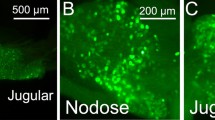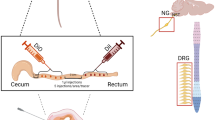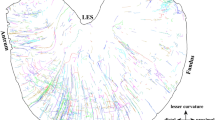Summary
In order to investigate the distribution and structure of the vagal liver innervation, abdominal vagal afferents and efferents were selectively labeled by injecting WGA-HRP or Dil into the nodose ganglia, and DiA into the dorsal motor nucleus, respectively. Vagal afferent fibers produced characteristic terminal-like structures at three locations in the liver hilus: 1. Fine varicose endings preferentially surrounding, but not entering, the numerous peribiliary glands in the larger intra and extrahepatic bile ducts 2. Large, cup-shaped terminals in almost all paraganglia 3. Fine varicose endings in the portal vein adventitia. No fibers and terminals were found in the hepatic parenchyma. While about two thirds of the vagal afferent fibers that originate in the left nodose ganglion, and are contained in the hepatic branch, bypass the liver hilus area on their way to the gastroduodenal artery, a significant number (approx. 10% of the total) of vagal afferents that do innervate the area, originates from the right nodose ganglion, and projects to the periarterial plexus of the common hepatic artery and liver pedicle most likely through the dorsal celiac branch. Varicose vagal efferent fibers were present within the fascicles of the vagal hepatic branch and fine terminal-like structures in a small fraction of the paraganglia. No efferents were found to terminate in the hepatic parenchyma or on the few neurons embedded in nerves or paraganglia. In contrast to the paucity of vagal terminals in the hepatic parenchyma, an abundance of vagal efferent and afferent fibers and terminals with distinctive distribution patterns and structural characteristics was present in esophagus and gastrointestinal tract. It is concluded that vagal intralobular hepatic innervation is largely absent in rats, and that the putative hepatic vagal nutrient, osmo-, and pressure receptors are located either in the portal vein, bile ducts, and/or the hepatic paraganglia.
Similar content being viewed by others
References
Adachi A, Niijima A (1982) Thermosensitive afferent fibers in the hepatic branch of the vagus nerve in the guinea pig. J Auton Nerv Syst 5:101–109
Adachi A, Niijima A, Jacobs HL (1976) An hepatic osmoreceptor mechanism in the rat: electrophysiological and behavioral studies. Am J Physiol 231:1043–1049
Alexander WF (1940) The innervation of the biliary system. J Comp Neurol 72:357–370
Azana MJ (1987) The vagal contribution to the rat liver innervation: a demonstration with the cobalt impregnation method. Comp Biochem Physiol 86A:275–279
Baertschi AJ, Vallet PG (1981) Osmosensitivity of the hepatic portal vein area and vasopressin release in rats. J Physiol (Lond) 315:217–230
Barja F, Mathison R (1984) Sensory innervation of the rat portal vein and the hepatic artery. J Auton Nerv Syst 10:117–125
Berthoud HR, Powley TL (1991) Morphology and distribution of efferent vagal innervation of rat pancreas as revealed with anterograde transport of DiI. Brain Res 553:336–341
Berthoud HR, Powley TL (1992) Vagal afferent innervation of the rat fundic stomach: morphological characterization of the gastrointestinal tension receptor. J Comp Neurol 319:261–276
Berthoud HR, Jedrzejewska A, Powley TL (1990) Simultaneous innervation of vagal innervation of gut and afferent projections from the visceral forebrain with DiI injected into the dorsal vagal complex in the rat. J Comp Neurol 301:65–79
Berthoud HR, Carlson NR, Powley TL (1991a) Topography of efferent vagal innervation of rat gastrointestinal tract. Am J Physiol 260 (Regulatory Integrative Comp Physiol 29): R200-R207
Berthoud HR, Fox EA, Powley TL (1991b) Abdominal pathways and central origin of rat vagal fibers that stimulate gastric acid. Gastroenterology 100:627–637
Cai WQ, Gabella G (1983) Innervation of the gall bladder and biliary pathways in the guinea pig. J Anat 136:97–109
Carobi C (1990) Vagal afferent innervation in regenerated rat liver. Experientia 46:50–53
Carobi C, Delia Torre G, Magni F (1985) Differential distribution of vagal afferent neurons from the rat liver. Neurosci Lett 62:255–260
Chen IL, Yates RD (1970) Ultrastructural studies of vagal paraganglia in syrian hamsters. Z Zellforsch Mikrosk Anat 108:309–323
Contreras RJ, Kosten T (1981) Changes in salt intake after abdominal vagotomy: evidence for hepatic sodium receptors. Physiol Behav 26:575–582
Dennhardt R, Ohm WN, Haberich FJ (1971) Die Ausschaltung der Leberäste des N. vagus an der wachen Ratte und ihr Einfluss auf die hepatogene Diurese — indirekter Beweis für die afferente Leitung der Leber Osmorezeptoren über den N. vagus. Pflügers Arch 328:51–56
Ding WG, Fujimura M, Mori A, Toojama I, Kimura H (1991) Light and electron microscopy of neuropeptide Y-containing nerves in human liver, gallbladder and pancreas. Gastroenterology 101:1054–1059
Forssmann WG, Ito S (1977) Hepatocyte innervation in primates. J Cell Biol 74:299–313
Fox EA, Powley TL (1985) Longitudinal columnar organization within the dorsal motor nucleus represents separate branches of the abdominal vagus. Brain Res 341:269–282
Goehler LE, Sternini C, Brecha NC (1988) Calcitonin gene-related peptide immunoreactivity in the biliary pathway and liver of guinea pig: distribution and colocalization with substance P. Cell Tissue Res 253:145–150
Goormaghtigh N (1936) On the existence of abdominal vagal paraganglia in the adult mouse. J Anat 71:77–90
Hollinshead WH (1946) The function of abdominal chemoreceptors of the rat and mouse. Am J Physiol 147:654–660
Inoue N, Magari S, Sakanaka M (1989) Distribution, possible origins and fine structure of neuropeptide Y-containing fibers in the rat liver. Brain Res 493:87–96
Jungermann K (1989) Regulation von Leberfunktion durch autonome hepatische Nerven. Naturwissenschaften 76:547–559
Kohno T, Mori S, Mito M (1987) Cells of origin innervating the liver and their axonal projections with synaptic terminals into the liver parenchyma in rats. Hokkaido J Med Sci 62:93–946
Koo A, Liang IYS (1979) Microvascular filling pattern in rat sinusoids during vagal stimulation. J Physiol (Lond) 295:191–199
Kummer W, Neuhuber WL (1989) Vagal paraganglia of the rat. J Electron Microsc Techn 12:343–355
Langhans W, Scharrer E (1987a) Evidence for a vagally mediated satiety signal derived from hepatic fatty acid oxidation. J Auton Nerv Syst 18:13–18
Langhans W, Scharrer E (1987b) Evidence for a role of the sodium pump of hepatocytes in the control of food intake. J Auton Nerv Syst 20:199–205
Lautt W (1983) Afferent and efferent neural roles in liver function. Progr Neurobiol 21:323–348
Lautt W, Wong C (1978) Hepatic parasympathetic neural effect on glucose balance in the intact liver. Can J Physiol Pharmacol 56:679–682
Mawe GM, Gershon MD (1989) Structure, afferent innervation, and transmitter content of ganglia of the guinea pig gall bladder: relationship to the enteric nervous system. J Comp Neurol 283:374–390
McDonald D, Blewitt RW (1981) Location and size of carotid body-like organs (paraganglia) revealed in rats by the permeability of blood vessels to Evans blue dye. J Neurocytol 10:607–643
Mesulam MM (1982) Tracing neuronal connections with horseradish peroxidase. Wiley, New York, 251 p
Metz W, Forssmann WG (1980) Innervation of the liver in guinea pig and rat. Anat Embryol 160:239–252
Morgan M, Pack RJ, Howe A (1976) Structure of cells and nerve endings in abdominal vagal paraganglia of the rat. Cell Tissue Res 169:467–484
Neuhuber WL (1987) Sensory vagal innervation of the rat esophagus and cardia: a light and electron microscopic anterograde tracing study. J Auton Nerv Syst 20:243–255
Neuhuber WL (1989) Vagal afferent fibers almost exclusively innervate islets in the rat pancreas as demonstrated by anterograde tracing. J Auton Nerv Syst 29:13–18
Niijima A (1977) Afferent discharges from venous pressoreceptors in liver. Am J Physiol 232 (Cell Physiol 1):C76-C81
Niijima A (1980) Studies on the nervous regulatory mechanisms of blood sugar levels. Pharmacol Biochem Behav 3 [Suppl 1]: 139–143
Niijima A (1982) Glucose-sensitive afferent nerve fibers in the hepatic branch of the vagus nerve in the guinea pig. J Physiol (Lond) 332:315–323
Niijima A (1983) Electrophysiological study on nervous pathway from splanchnic nerve to vagus nerve in rat. Am J Physiol 244:R888-R890
Passo SS, Thornborough JR, Rothballer AB (1973) Hepatic receptors in control of sodium excretion in anesthetized cats. Am J Physiol 224:373–375
Powley TL, Berthoud HR (1991) A fluorescent labeling strategy for staining the enteric nervous system. J Neurosci Methods 36:9–15
Prechtl JC, Powley TL (1990) The fiber composition of the abdominal vagus of the rat. Anat Embryol 181:101–115
Rogers RC, Hermann GE (1983) Central connections of the hepatic branch of the vagus nerve: a horseradish peroxidase histochemical study. J Auton Nerv Syst 7:165–174
Rogers RC, Novin D (1980) The neurobiology of hepatic osmoregulation and its implications for studies of ingestive behavior. Brain Res Bull 5 [Suppl 4]: 189–194
Rogers RC, Karilas PJ, Herman GE (1984) Projection of the hepatic branch of the splanchnic nerve to the brainstem of the rat. J Auton Nerv Syst 11:223–225
Russek M (1963) An hypothesis on the participation of hepatic glucoreceptors in the control of food intake. Nature 197:79–80
Sawchenko PE, Friedmann MI (1979) Sensory functions of the liver a review. Am J Physiol 236 (Regulatory integrative Comp Physiol 5):R5-R20
Shimazu T (1971) Regulation of glycogen metabolism in liver by the autonomic nervous system V. Activation of glycogen synthetase by vagal stimulation. Biochim Biophys Acta 252:28–38
Shimazu T (1979) Nervous control of peripheral metabolism. Acta Physiol Polonica [Suppl 18]:1–18
Skaaring P, Bierring F (1977) Further evidence for the existence of intralobular nerves in the rat liver. Cell Tissue Res 177:287–290
Stavney LS, Kato T, Griffith CA, Nyhus LM, Harkins HN (1963) A physiologic study of motility changes following selective gastric vagotomy. J Surg Res 3:390–394
Sutherland SD (1965) The intrinsic innervation of the liver. Rev Internat Hepatol 15:569–578
Tanaka K, Inoue S, Nagase H. Takamura Y, Niijima A (1990) Amino acid sensors sensitive to alanine and leucine exist in the hepato-portal system in the rat. J Auton Nerv Syst 31:41–46
Terada T, Nakamura Y (1989) Innervation of intrahepatic bile ducts and peribiliary glands in normal human livers, extrahepatic biliary obstruction and hepatolithiasis. An immunohistochemical study. J Hepatol 9:141–148
Tordoff MG, Rawson N, Friedman MI (1991) 2,5-Anhydro-d-mannitol acts in liver to initiate feeding. Am J Physiol 261 (Regulatory integrative Comp Physiol 30):R283-R288
Tsai TL (1958) A histological study of sensory nerves in the liver. Acta Neurovegetativa 17:354–385
Author information
Authors and Affiliations
Rights and permissions
About this article
Cite this article
Berthoud, H.R., Kressel, M. & Neuhuber, W.L. An anterograde tracing study of the vagal innervation of rat liver, portal vein and biliary system. Anat Embryol 186, 431–442 (1992). https://doi.org/10.1007/BF00185458
Accepted:
Issue Date:
DOI: https://doi.org/10.1007/BF00185458




